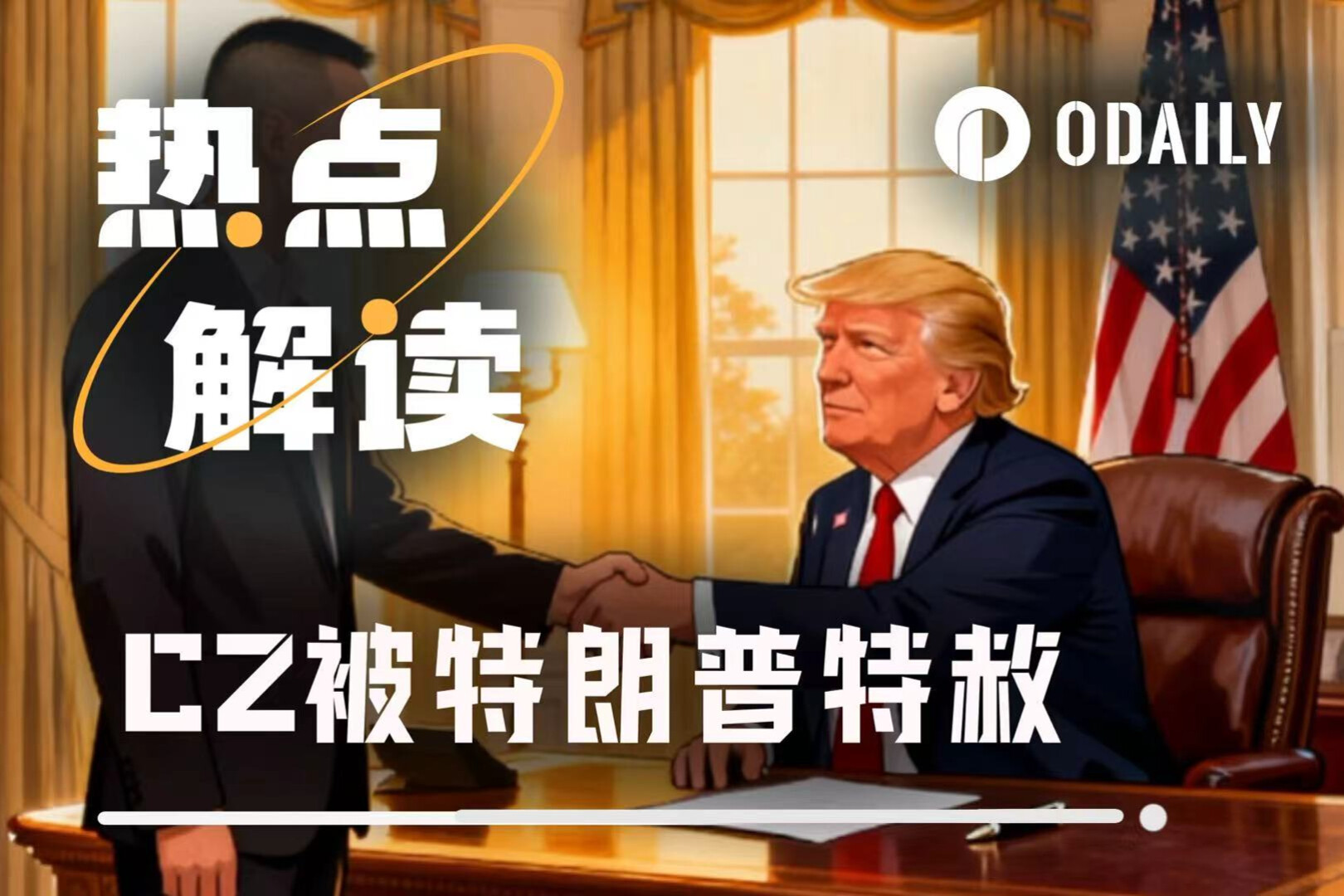Original title: "Unveiling the Myth of Cryptocurrency Wealth: How Did They Earn Their First 10 Million?"
Original Biteye Biteye Chinese
August 8, 2025, 4:24 PM, Hong Kong, China
》Original author: Author: @alpha_gege
Original Source: Biteye
Whenever the market fluctuates, some friends will ask, "Why are others so financially free?"
Today, I'll share with you how the 10 richest crypto tycoons made their fortunes. Where did they make their first pot of gold? What were their unique strategies? After reading this, be sure to copy their own experiences; after all, these are the same paths these tycoons have taken and the pitfalls they've encountered!
01 List of famous tycoons in the cryptocurrency circle
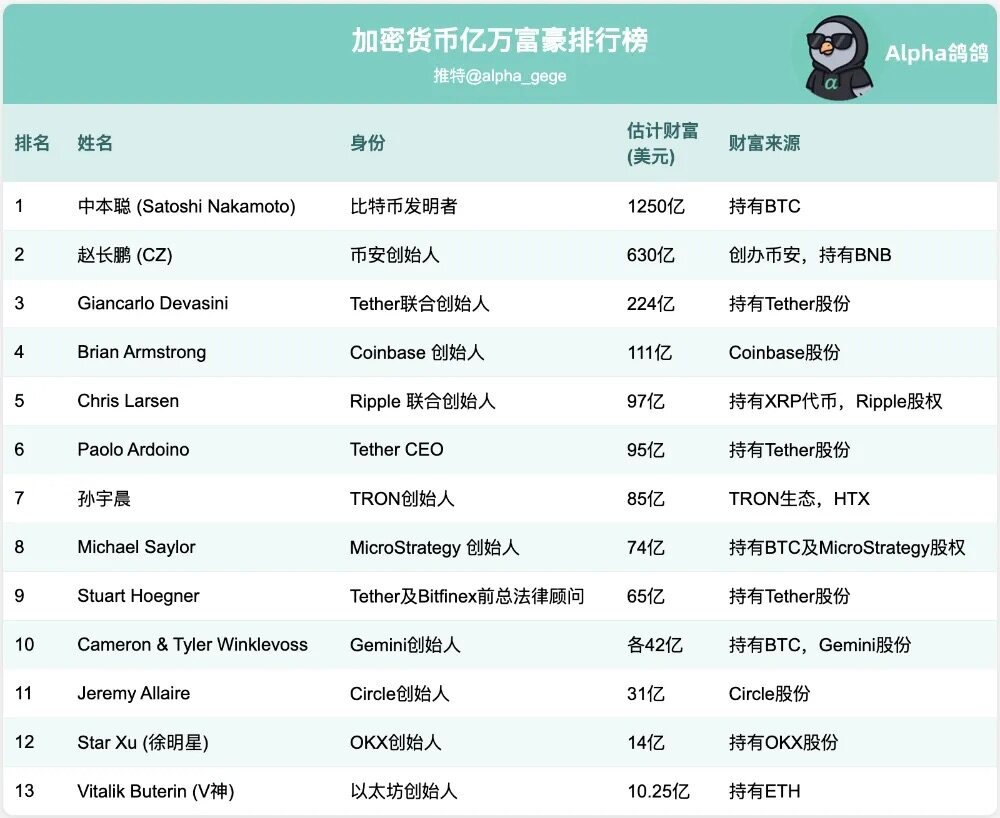
Note: The above is an estimate of public wealth. Actual market fluctuations may affect asset value.
Next, let’s look at the stories of these cryptocurrency tycoons and how they each made their first pot of gold.
1. Satoshi Nakamoto
When discussing the richest people in the cryptocurrency world, one cannot avoid the enigmatic figure of Bitcoin's creator, Satoshi Nakamoto. He published the Bitcoin white paper in 2008 and officially launched the Bitcoin network in 2009, earning him the nickname "the father of cryptocurrency." His true identity remains unknown, and he has never made a public appearance, remaining one of the greatest mysteries in the cryptocurrency world.
Although no one knows his identity, the approximately 1.1 million Bitcoins he mined in his early days became his first pot of gold. These Bitcoins, almost never moved or sold, have rapidly appreciated in value as Bitcoin's price soared, and are now worth approximately $125 billion! It can be said that the more successful Bitcoin becomes, the more valuable his holdings become. However, Satoshi Nakamoto himself has disappeared since 2010, and some even speculate that he may have lost his private keys or is no longer alive. Regardless of the truth, the wealth Nakamoto created by leveraging his first-mover advantage is undoubtedly the pinnacle of the cryptocurrency world.
2. Changpeng Zhao
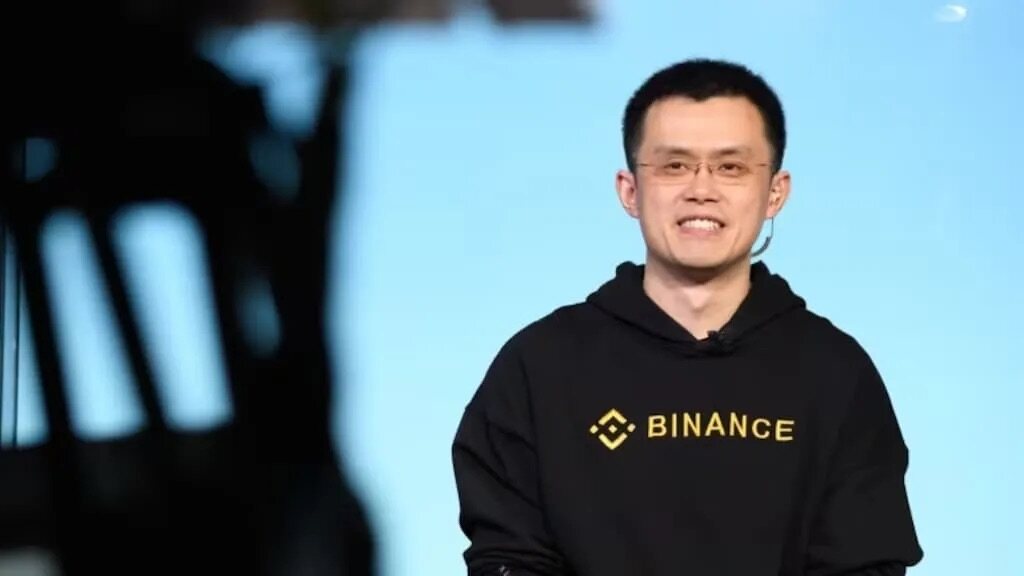
As the founder of Binance, Changpeng Zhao's experience is practically a textbook example of cryptocurrency entrepreneurship. CZ, a technical coder in his early years, co-founded the OKCoin exchange but soon withdrew. His first pot of gold dates back to 2014, when he sold his house in Shanghai for approximately 1,500 Bitcoins (then priced at around $600 per coin). Bitcoin's skyrocketing price in the following years allowed CZ to realize significant asset appreciation and laid the foundation for his subsequent entrepreneurial ventures.
In 2017, he keenly capitalized on the cryptocurrency bull market and founded Binance. Leveraging its efficient matching engine, user-friendly experience, and the issuance of its native token, BNB, at the heart of its ecosystem, Binance rose to become one of the world's largest cryptocurrency exchanges in just a few months. Binance's initial profit model was straightforward: matching transaction fees plus the appreciation of its native token. Think of it this way: exchanges collect tolls; the hotter the market and the more transactions, the more they profit. Subsequently, CZ's personal wealth snowballed thanks to the success of Binance, ultimately becoming the richest Chinese person. Creating the exchange put CZ on the fast track to wealth, and his unwavering commitment to investing all in Bitcoin was a crucial step in his rise to wealth.
3. Giancarlo Devasini
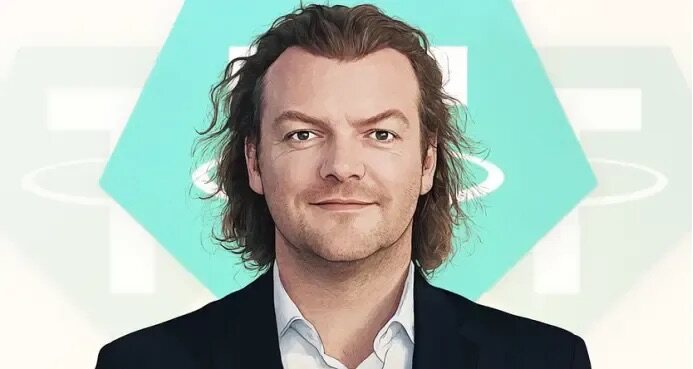
Giancarlo Devasini may not be familiar to many, but everyone involved in the cryptocurrency world knows USDT, issued by the company he founded, Tether. He originally trained as a plastic surgeon, but eventually grew bored and switched to electronics. Devasini made his first fortune in crypto with an investment in the Bitfinex exchange in 2012, and then co-founded the Tether stablecoin project in 2014. At the time, the stablecoin market was largely undeveloped, but Devasini, with his foresight, saw this opportunity and established USDT as a USD alternative. Today, USDT is the primary stablecoin used by major exchanges. The resulting surge in valuation has fueled his explosive wealth in recent years. Simply put, he identified a market gap and pursued it relentlessly.
4. Brian Armstrong
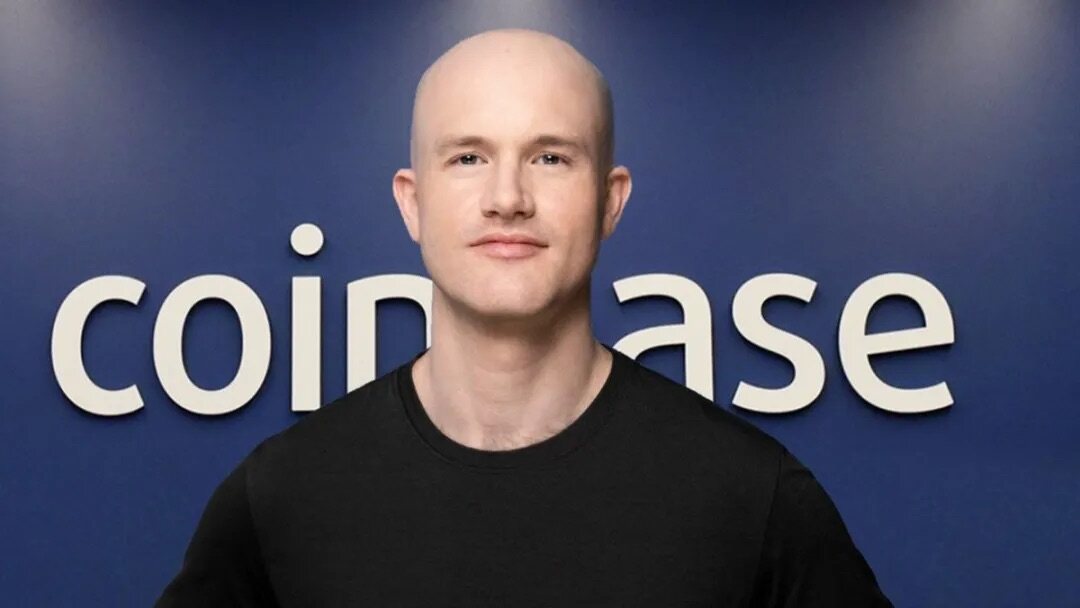
Brian Armstrong, founder of Coinbase, the largest US exchange, took a completely different approach. A software engineer, he first encountered Bitcoin while working at Airbnb around 2010 and was acutely aware that the process for purchasing Bitcoin was cumbersome and unfriendly. In 2012, he resolutely resigned to start Coinbase, which soon secured seed funding from Y Combinator and subsequently attracted venture capital funding from firms including the New York Stock Exchange. This provided him with ample early funding, and his first pot of gold came from venture capital financing. From the outset, Coinbase adhered to a compliant approach, a slower but more stable path. Coinbase not only obtained a legal license in the US but also successfully listed on the Nasdaq in 2021, with its market capitalization briefly exceeding $100 billion.
Notably, Coinbase later partnered with JPMorgan Chase, a veteran investment bank, to open up access to traditional banking funds, allowing bank customers to purchase cryptocurrencies directly with their credit cards. This series of regulatory compliance operations not only made Armstrong profitable, but also established him as a bridge between traditional finance and the crypto world.
5. Chris Larsen
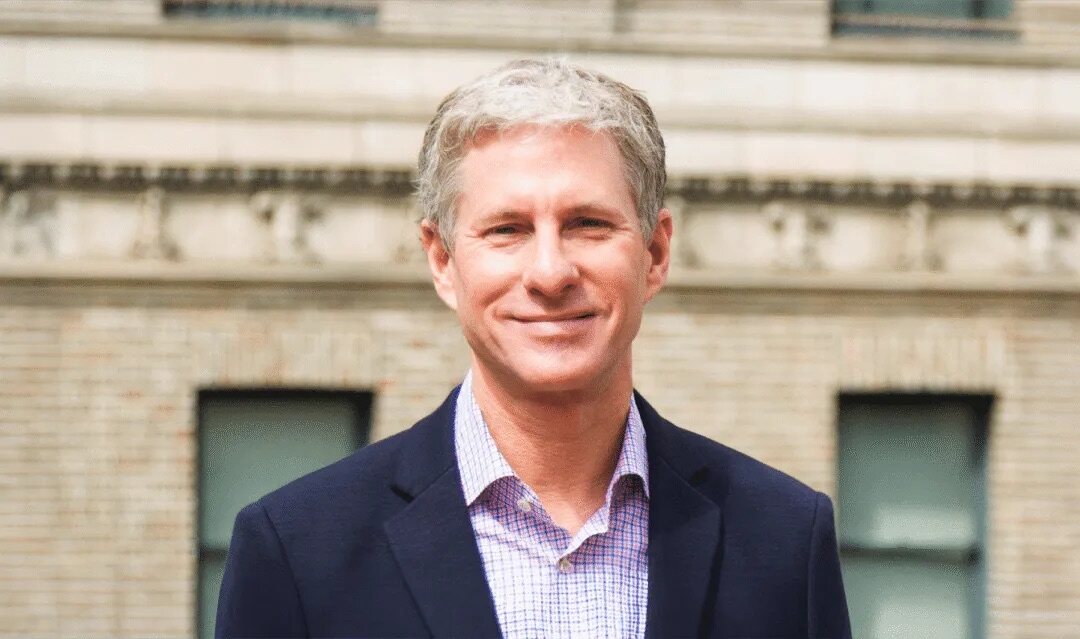
Before entering the blockchain field, Chris Larsen was an entrepreneur in the financial sector, founding the online lending company E-Loan in the 1990s. He later co-founded the peer-to-peer lending platform Prosper, thriving in the traditional financial world. As such, he is deeply familiar with the pain points of the payments sector.
In 2012, Larsen co-founded Ripple, launching the Ripple payment protocol and the XRP cryptocurrency, aiming to transform cross-border payments with blockchain technology. His initial investment in the cryptocurrency industry arguably came from his involvement in Ripple and his early holdings of XRP tokens. Ripple secured multiple rounds of funding between 2014 and 2016, and as a co-founder, Larsen naturally held a significant amount of XRP and company equity. In 2017, XRP's price soared hundreds of times, propelling Larsen's personal wealth to the top of the crypto rich list. Although XRP prices have since fallen, Larsen's substantial holdings have helped him maintain his position among the wealthiest individuals in the cryptocurrency world.
6. Paolo Ardoino
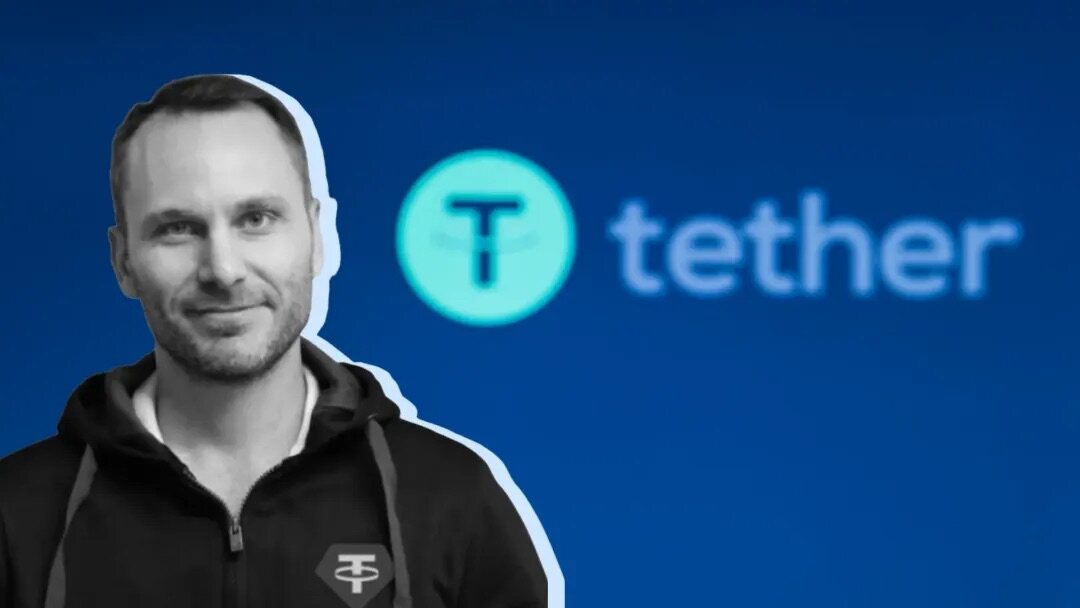
Tether's current CEO, Paolo Ardoino, is also a technical proficiency. In 2014, proficient in computer programming, he joined Bitfinex. With his solid technical skills, Paolo quickly resolved a series of early system challenges at Bitfinex, demonstrating his exceptional architectural capabilities. This attracted the attention of Tether founder Devasini, and soon after, Paolo was invited to serve as Tether's Chief Technology Officer (CTO). Paolo's first pot of gold arguably came from equity incentives he received at Tether. When he joined, USDT issuance was only in the tens of millions. However, he helped the stablecoin rapidly expand to over a dozen major public blockchains, including Ethereum, Tron, and Solana, significantly increasing USDT's daily trading volume and application scenarios.
It can be said that he traded his technical prowess for a real financial return. When Tether raked in billions of dollars from interest income, Paolo, as a shareholder, received generous dividends. This investment in technology, coupled with the rapid growth of the stablecoin industry, made him a legendary financial powerhouse.
7. Justin Sun

Justin Sun is a name everyone should be familiar with. At just 19, he became an early representative for Ripple in Greater China and later secured investment for his own social app, "Peiwo." But it was the TRON project, launched in 2017, that truly made Sun his fortune. During the ICO boom, Sun raised tens of millions of dollars by issuing TRX tokens, accumulating a substantial amount of seed capital. Then, as the crypto market soared, TRX prices surged a hundredfold, instantly increasing the value of Sun's holdings. As the founder of TRON, he also held a significant number of initial tokens, making him a fortune during that bull market.
Since then, Justin Sun has embarked on a series of bold marketing and capital operations. He catapulted himself to fame by spending $4.56 million to win a Buffett lunch; he subsequently acquired the Poloniex exchange and invested in Huobi (now HTX), building his own crypto presence. Sun's approach is straightforward and unpretentious, focusing on both technological advancements and market attention. Despite mixed reviews, he has seized the opportunities afforded to young people by the times, propelling himself to the ranks of the cryptocurrency world's richest.
8. Michael Saylor
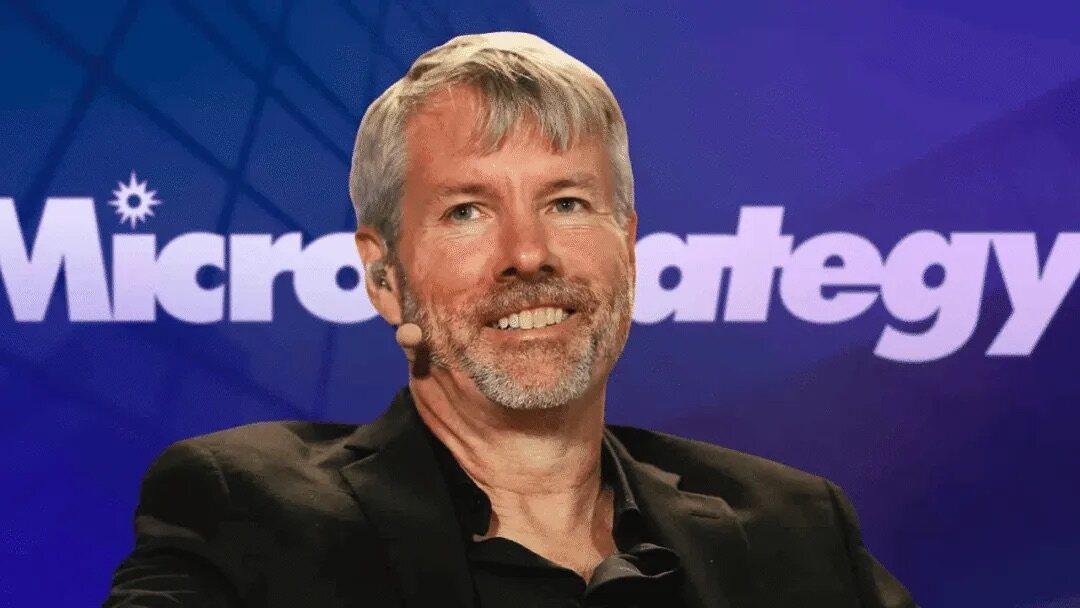
Michael Saylor's story is somewhat different. The founder of MicroStrategy, a business intelligence software company, was once a traditional tech billionaire. However, in 2020, now in his fifties, he suddenly went all-in on Bitcoin. Recognizing Bitcoin's potential and the potential inflationary risks of the US dollar, Saylor made the surprising decision to convert the majority of MicroStrategy's cash reserves into Bitcoin. This was equivalent to staking a multi-billion dollar company's fortune on Bitcoin. Many people thought he was crazy at the time, considering he was a Nasdaq-listed company after all!
But Saylor's judgment proved true. MicroStrategy began purchasing Bitcoin in August 2020, and by 2025, it held over 600,000 BTC, making it one of the world's largest publicly traded companies. This series of aggressive moves earned him rich rewards in the crypto space. As Bitcoin's price subsequently surpassed $100,000, his paper profits exceeded $10 billion, and the company's stock price multiplied several times. Today, MicroStrategy has simply designated Bitcoin as its primary reserve asset, and Saylor has become the spiritual leader of the "radical bulls" in the cryptocurrency world.
9. Stuart Hoegner

Stuart Hoegner is a relatively low-key figure in the cryptocurrency world, but in terms of wealth, he's undoubtedly a hidden tycoon. A lawyer, Hoegner has long been interested in digital currency legal compliance. In 2014, long before cryptocurrencies became mainstream, he joined the Bitfinex and Tether teams. At the time, the industry was mired in regulatory uncertainty, and survival was uncertain. Hoegner withstood immense pressure and gradually established a legal and compliance framework for Tether. For example, he promoted regular reserve audits and transparency disclosure policies, significantly enhancing market trust in USDT. His initial wealth came from his Tether equity holdings as a founding member. Unlike other high-profile tycoons, Hoegner rarely gives interviews and rarely appears in public, exemplifying the quiet individual who thrives in the cryptocurrency world.
10. Cameron & Tyler Winklevoss

Twin brothers Cameron and Tyler, who settled their lawsuit with Mark Zuckerberg over the rights to create Facebook, received approximately $65 million in damages, which became the starting point for their involvement in the cryptocurrency world. The brothers used their profits from the Facebook lawsuit to invest heavily in Bitcoin at a low price in 2013. This foresight made them among the earliest major Bitcoin holders.
While the Gemini exchange the brothers later founded has only modestly performed, this hasn't diminished the lucrative returns their early Bitcoin investment brought them. To date, they are said to still hold approximately 70,000 Bitcoins. With their initial initial investment paving the way, coupled with their long-term belief in Bitcoin, the Winklevoss brothers have achieved a sustained increase in their wealth.
11. Jeremy Allaire
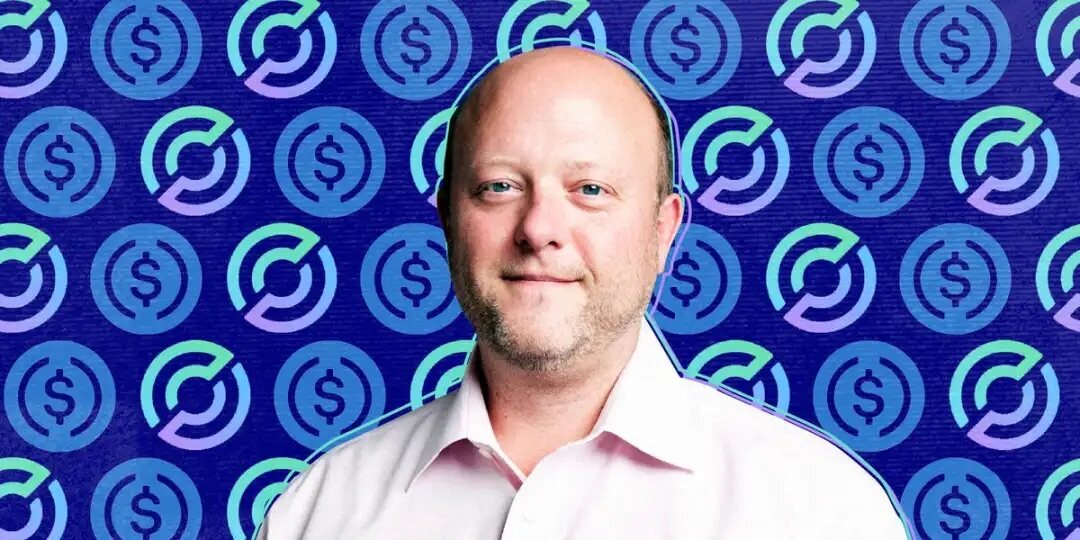
Jeremy Allaire created USDC, the world's second-largest stablecoin. Having founded companies like the video platform Brightcove in the early internet era, he keenly recognized the opportunities in digital currencies and founded Circle in 2013, with the initial vision of making cryptocurrency more accessible to the general public. After several transformations, Circle partnered with Coinbase in 2018 to launch USDC, a US dollar stablecoin. Leveraging Coinbase's influence and user network, USDC rapidly expanded its market share. Allaire's first digital fortune came from the success of Circle and the rise of USDC.
As USDC issuance exceeded tens of billions of dollars, Allaire's personal wealth also jumped significantly between 2021 and 2023. Although USDC's current market value is slightly lower than USDT, Allaire has successfully entered the ranks of crypto billionaires.
12. Xu Mingxing
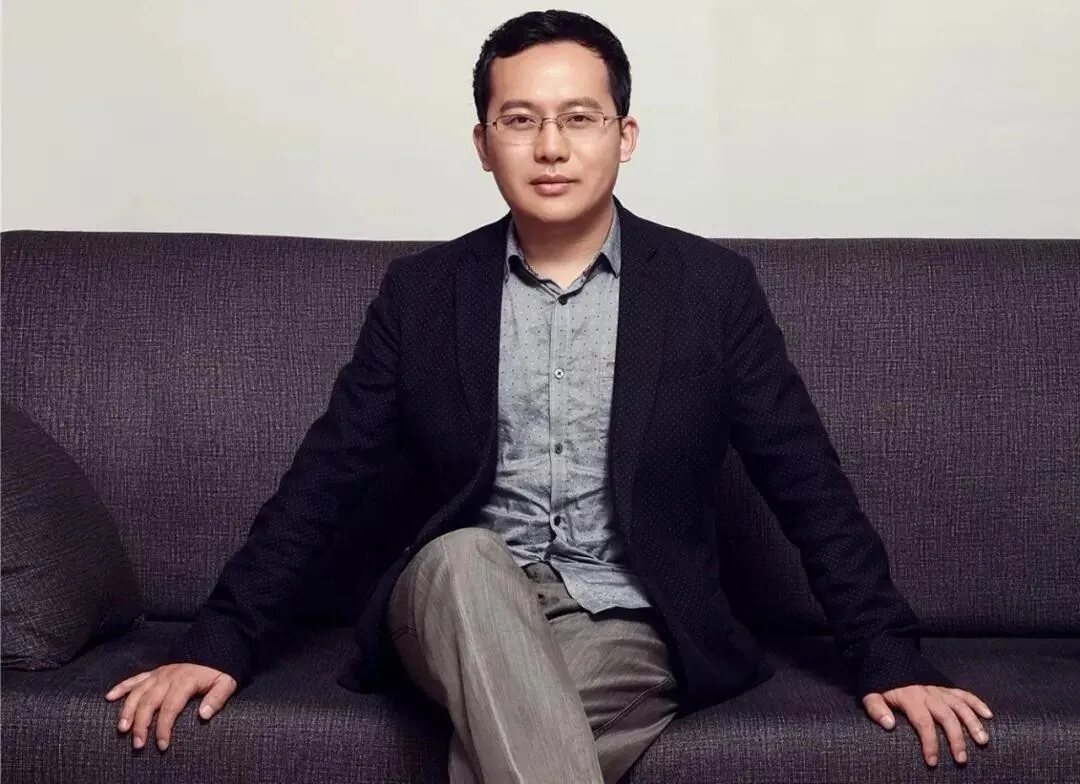
Xu Mingxing was one of the earliest entrepreneurs in China to invest in the crypto industry and the founder of OKCoin/OKX, one of the "Big Three" exchanges in the cryptocurrency world. In 2013, at the age of 28, Xu founded OKCoin, a time when China's Bitcoin exchanges were dominated by three major players (the other two being Huobi and BTC China). Leveraging solid product development and marketing expertise, Xu quickly built OKCoin into a major player, ultimately dominating the domestic trading market. His initial investment naturally came from the exchange's profits and its platform token. OKCoin later evolved into OKEx and issued its platform token, OKB. The platform's daily transaction fees, combined with OKB's appreciation, made Xu a lucrative business.
It is worth mentioning that he also invited He Yi, Zhao Changpeng and others to join in his early years, although they later parted ways due to differences in ideas.
13. Vitalik Buterin
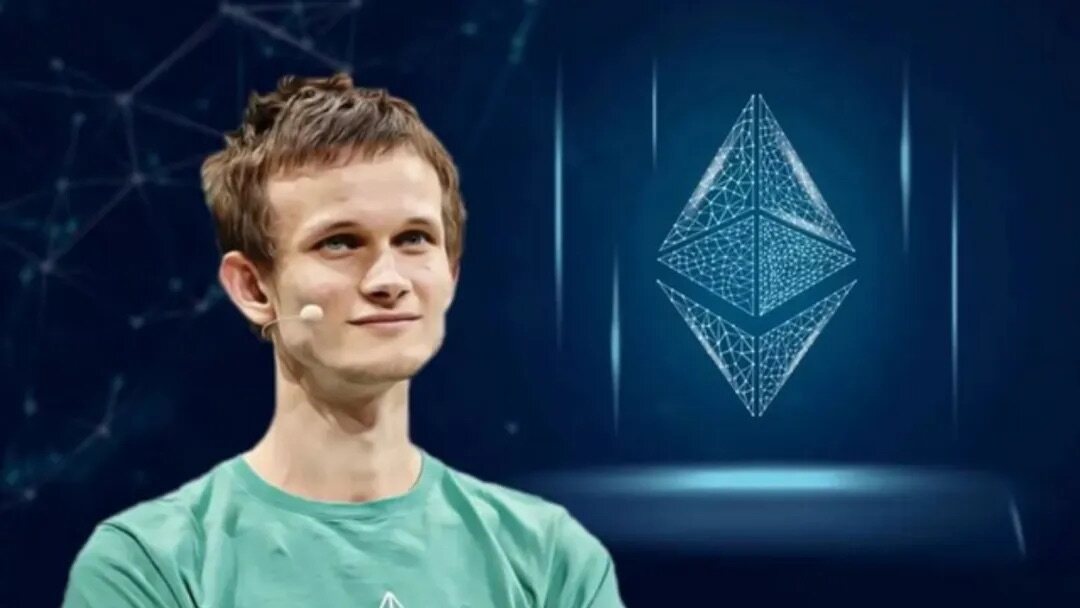
Vitalik Buterin, the father of Ethereum, is known in the Chinese community as "V God." At just 19 years old, he authored the Ethereum white paper based on his ideas for improving Bitcoin. In 2014, Vitalik launched the Ethereum project through a crowdfunding campaign, and as a co-founder, he also held a significant amount of initial ETH. The birth of Ethereum opened the door to smart contracts and decentralized applications, extending the blockchain's reach beyond Bitcoin. Vitalik's first pot of gold came from his early Ethereum holdings.
However, this tech geek isn't obsessed with money. He has repeatedly donated significant amounts of crypto assets to charity and scientific research, and has publicly expressed his concerns about the crypto bubble. Despite this, thanks to his status as the creator of the Ethereum public blockchain, Vitalik Buterin is still considered one of the most influential figures in the cryptocurrency world. He has proven that young developers can change the world and reap wealth through technological innovation.
02 Summary of the path to getting rich quickly: Three major wealth creation models subvert traditional logic
After reading the stories of these cryptocurrency giants, you might be wondering: What commonalities exist in their rapid success? Ge Ge has summarized three key strategies behind these crypto wealth legends, offering "paths to rapid wealth" that defy traditional logic.
1. The King of Exchanges
The first category is "owning an exchange and becoming the biggest," with CZ and Xu Mingxing being prominent representatives. The core of an exchange's profitability lies in "collecting transaction fees and building an ecosystem." As long as users trade with you, you'll receive a steady stream of commissions. Another major exchange, Coinbase's Armstrong, chose the compliant path to a public listing, diligently obtaining a license and listing on the Nasdaq. The exchange industry is currently experiencing a significant market saturation, allowing users to profit from transaction fees while also further amplifying their returns through the platform token ecosystem. The appeal of this path lies in the fact that as long as you are at the entrance to the industry's capital flow, wealth will flow to you continuously.
2. Hold Bitcoin for the long term
The first model is difficult for most people to achieve today. The second model involves long-term Bitcoin holding. In other words, it involves placing a heavy bet and holding onto a promising crypto asset for the long term, relying on time to see its value grow exponentially. Michael Saylor is one of the most prominent Bitcoin bettors. Even though he only began accumulating significant amounts of Bitcoin in 2020, he is currently one of the top three Bitcoin holders in the world. If you believe Bitcoin will increase a hundredfold over the next decade, then investing heavily early on will undoubtedly yield astonishing compounding benefits. Of course, this path requires exceptional foresight and a strong conviction in holding onto the cryptocurrency; otherwise, you'll easily be swept away by the sudden rise and fall of prices.
3. Ecosystem Builder
The third category is ecosystem builders, who often possess both technical talent and capital foresight, accumulating immense wealth by building entirely new ecosystems. Ethereum, led by Vitalik Buterin, began writing the white paper at the age of 19 and continues to lead technological iterations today. Since its launch in 2014, Devasini and Paolo have made USDT the core of market liquidity, with the ecosystem fueling the token's value. Jeremy Allaire launched USDC, which took over 10 years to establish its position as the "on-chain dollar." Justin Sun, through TRON, has developed a comprehensive ecosystem from blockchain, stablecoin, to exchange, honing his skills as he went along. These individuals didn't just "capture the opportunity"; they spent time building a moat and achieving their current status through long-term development.
03 What can ordinary people learn from the big guys in the cryptocurrency world?
Gege has summarized some valuable information, hoping to help everyone avoid pitfalls and make more comebacks in the turbulent times of the cryptocurrency world:
1. Good vision and quick action
Satoshi Nakamoto created BTC, CZ founded Binance; these wealth legends all began with a bold idea. When the opportunity arises, jump on board decisively. Don't wait until most people understand the situation before you act, as by then the market has cooled. Opportunities always come to those who take the plunge first.
2. Hold on to your chips
The secret to wealth shared by cryptocurrency giants isn't frequent trading, but holding onto good projects for the long term. The most common mistake ordinary people make is chasing rising and falling prices, failing to hold onto their holdings, and ending up with small profits and large losses. Either don't get involved, or if you do, have faith. Hold on to good things and don't mess around. Time will reward you handsomely.
3. Find your strengths
Everyone has their own professional strengths. Combining these strengths with opportunities in the cryptocurrency world significantly increases your chances of success. Ripple founder Larsen excels in finance and cross-border payments, while CZ excels in technology and matching engines. They've both leveraged their core expertise to leverage new markets, achieving greater success with less effort. Think about your strengths and then explore related areas within the crypto space where you can delve deeper.
4. Live and learn
The crypto industry is rapidly changing, and these leaders all share one thing in common: a keen sense of new knowledge and a passion for continuous learning. New blockchain concepts are constantly emerging, and without constant learning, it's easy to miss out on the next wave of opportunities or even fall into pitfalls. Remember, to survive in the cryptocurrency world, learning and self-improvement are always the most cost-effective investments.
Finally, a friendly reminder from Gege: While the myths of wealth in the cryptocurrency world are certainly alluring, always remember that high returns always come with high risks! While you can learn from the success stories of influential individuals, no one can completely replicate their life. After all, the true path still lies in your own hands. Finding a way to make money that works for you is more important than blindly following others.
- 核心观点:币圈富豪靠三大模式暴富。
- 关键要素:
- 交易所模式:手续费+生态盈利。
- 长期持币:比特币复利效应显著。
- 生态构建:技术+资本打造护城河。
- 市场影响:激励行业创新与长期投资。
- 时效性标注:长期影响。



